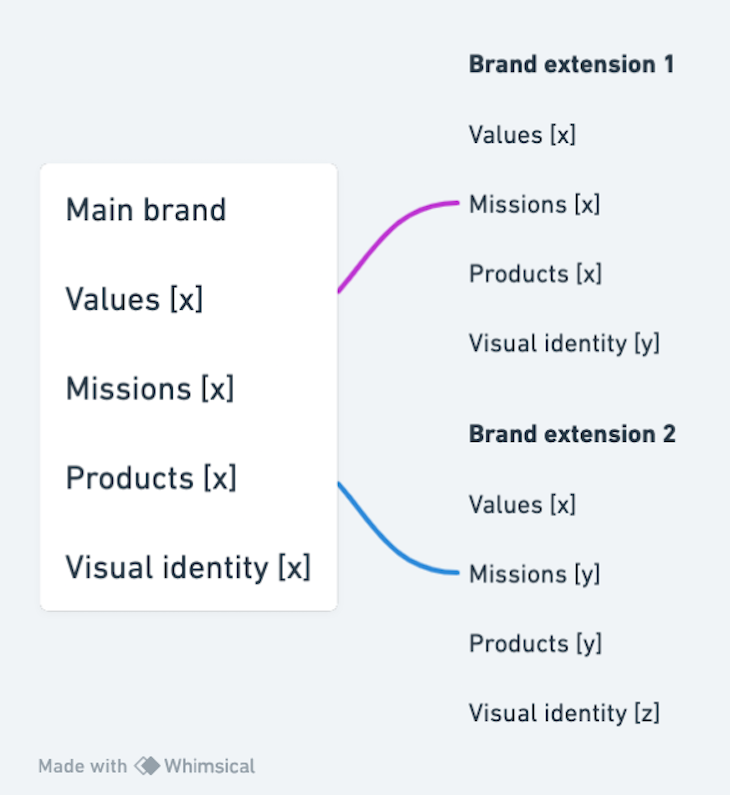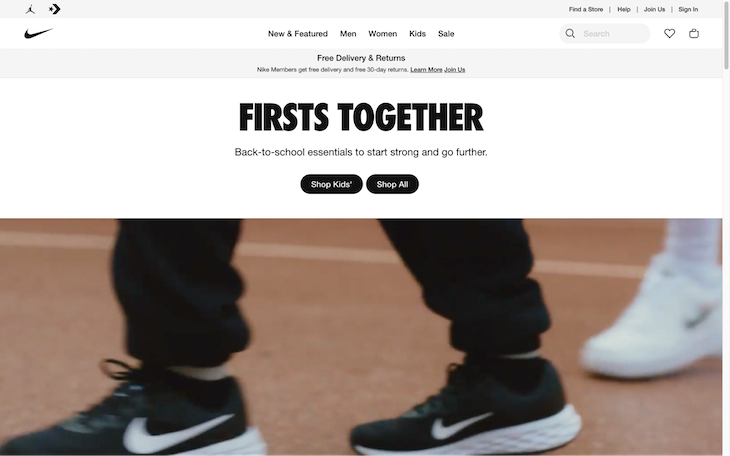So, you’re faced with a new product or service, but it feels “off-brand.” You contemplate starting a separate business for this product or service, but you don’t want to start from scratch in terms of reputation and marketing reach; after all, this new product or service isn’t entirely different from what you’re already offering.

One way to handle this is to create what’s called a brand extension.
In this article, you’ll learn what a brand extension is, when and why they’re useful, and how to go about creating one. We’ll also take a look at some brand extensions that were pulled off successfully, as well as some that weren’t.
A brand extension is an independent brand that’s separate from the main brand and any other brand extensions because they have different values, missions, products, and/or visual identities, while also sharing some of those attributes:

Metaphorically speaking, if a brand were a movie or a TV show, then its brand extension could be likened to a spinoff. Some people would be interested in the brand extension because they like the main brand, but it can also be appreciated individually.
Brand extensions are useful for when businesses need to craft a new identity to target a different market while still being able to leverage the reputation and marketing reach of their preexisting brands.
For example, a sportswear brand that helps young boys to get serious about sports might prefer a new line of products that empowers girls of any age to play sports with confidence to be an extension of the brand, because presenting them as a singular brand might make it difficult to communicate the right brand messages. On the other hand, presenting them separately would somewhat prevent the new brand from being able to leverage the reputation and marketing reach of the preexisting brands.
This is why a brand extension offers the best of both worlds.
If the brand extension’s product offering isn’t related to that of the brand that it’s an extension of, then the brand extension is better off just being a separate brand. Additionally, if any of the connected brands have a bad reputation, then the brand extension will somewhat inherit that reputation.
Vice-versa, if the brand extension gets a bad reputation or doesn’t do well for any other reason, it can reflect badly on all brands involved. However, this can be mitigated by cutting it loose (to some extent).
And finally, having too many brand extensions can dilute the brand.
This makes it seem as if it isn’t committed to a mission and doesn’t specialize in a particular expertise, which is one of the reasons why big brands like Google and Virgin seem eager to abandon ventures.
So now that you know the whens and whys of setting up a brand extension, let’s take a look at how brand extensions can make product management easier.
Let’s start at the beginning — the brand’s launch. A good launch helps to build momentum; without it, the brand can run into trouble recuperating its initial investments and experience slow growth when it’s needed most. Setting up a brand extension to leverage the resources of its allied brands can reduce the likeliness of that happening.
Also, since the brand extension will likely have its own platforms, product managers will find it easier to track how well the brand extension is performing, post-launch and forevermore, while also increasing the brand’s overall marketing reach.
At worst, allied brands can “stop associating” with the brand extension, or just shut it down completely. At best, the brand extension becomes so successful that the benefits become two-way.
Next, let’s take a look at some successful and unsuccessful brand extensions, paying particular attention to how they went about it and why they saw the outcome they did.
Colgate’s brand extension into frozen food wasn’t successful despite toothpaste’s connection to food because it was difficult to look at Colgate Lasagne and imagine the taste as anything but cleaning chemicals and minty fresh (or Levi’s Tailored Classics as anything but rugged). The brand’s connotations just didn’t compliment the brand extension.
Wix, a drag n’ drop website builder for non-designers, wasn’t successful initially. Their new tool and brand extension (Editor X by Wix) targets designers with the professional tools that Wix doesn’t have, but it’s difficult to erase the preconception of who Wix has traditionally been for.
However, since they’ve begun referring to it as just “Editor X”, they’ve managed to distance themselves from those preconceptions. It’s a great product idea for Wix because of their knowledge of how people build websites, but ultimately the only benefit of being an extension of Wix was its option to effortlessly decouple from them as damage control.
Facebook, simply put, launched Instagram as a brand extension so that it could leverage Facebook’s popularity. They’re both social media platforms too, so it makes sense in pretty much every way. They were entwined from a product/technological point of view, and they started off by referencing it as “Instagram by Facebook.”
They did the same thing with WhatsApp and they’re doing the same thing with Threads now. It didn’t make sense for Wix, but it does for Facebook (now Meta).
Similarly, Adidas partnered with Kanye West to create Yeezy, combining their marketing reach with his popularity, but while protecting the Adidas name. This enabled them to pull back from the venture as Kanye’s likability diminished, safeguarding the brand from a PR disaster.
The best way to assess the viability of a brand extension is to see if the venture fits into any of the following categories. Although just one category match is fine, you should consider just one mismatch as a total dealbreaker.
Firstly, there’s the product-based brand extension — this is when the product is moderately related, such as part a toolset but not a worksuite or part of a lifestyle but not a hobby — some existing customers will be interested, but some won’t be.
Next, the identity-based brand extension — this is when the brand extension has different values, missions, and/or visual identities that need to be expressed. In any case, make sure that all of the main brand’s connotations compliment the brand extension.
Also, the asset-based brand extension is when the brand extension stands to benefit from having its own app, website, newsletter, and/or social media accounts. This can be for UX reasons, or to make it easier to observe and measure success.
Finally, the popularity-based brand extension is when having a totally fresh identity creates an initial buzz. If collaborating with a third-party, having a totally fresh name as well can protect brands from PR disasters (to an extent). These brand extensions are usually temporary.
Remember, having too many brand extensions can dilute the brand — something to consider if this isn’t your first rodeo!
In terms of planning and executing a brand extension successfully, there’s actually not much to it. If you’ve decided upon a brand extension for the right reason(s), then you’re already half-way there.
After that, ensure that you have the right resources to do this. It won’t be as intense as starting a totally new brand from scratch, but it won’t be far off either. You’ll typically use the same tools and processes, but you’ll need the people power to execute them, and if their bandwidth is already being used up, then you’ll need to look into expanding your product team.
With the right product team at hand, you’ll need to look into creating your assets. Think: apps, websites, newsletters, social media pages, and so on (again, just as you would with any other brand).
Next, establish the connection. Mention and/or link to your brand extension from your allied brand’s social media pages (and vice-versa), and then do the same with your websites. In fact, consider including what’s called a brand banner (at least that’s what Nike calls it), as shown in the image below. This presents the brand extension with more authority, although all mentions (including footer mentions) are great too:

If the brand extension goes by a totally different name, consider referring to it as “[brand extension] by [brand]” (just like how Wix used “Editor X by Wix”), as this awards you the flexibility to drop the “by [brand]” part if necessary.
Finally, introduce yourself, cross-promote, and market the new brand just as you would with any other brand.
Brand extensions can be incredibly powerful, kickstarting new ventures into high-growth where normally that’d be difficult or impossible, sometimes even becoming so powerful that they match the original brand, surpass it, or even supersede it!
Creating a brand extension is definitely something to consider when exploring a new venture that feels off-brand, even just for the practical benefits of being able to manage it independently, or the ability to easily cut it loose if it doesn’t work out.
Featured image source: IconScout

LogRocket identifies friction points in the user experience so you can make informed decisions about product and design changes that must happen to hit your goals.
With LogRocket, you can understand the scope of the issues affecting your product and prioritize the changes that need to be made. LogRocket simplifies workflows by allowing Engineering, Product, UX, and Design teams to work from the same data as you, eliminating any confusion about what needs to be done.
Get your teams on the same page — try LogRocket today.

Most teams fail at autonomy. Learn how clear rules help product teams move faster without micromanagement.

A practical framework for PMs to use AI in ideation without sacrificing judgment, strategy, or decision quality.

A practical five minute revenue estimation method to help product managers compare ideas, drop low impact features, and prioritize smarter.

A practical guide for PMs who want to stop being bottlenecks, delegate smarter, and lead teams effectively with a clear ownership framework.